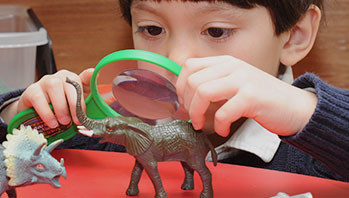- chart paper
- four to five different foods such as carrots (crunchy), applesauce (sweet), pretzels (salty), cheese, salsa, guacamole, and an unfamiliar food that children might like to try
- markers
- star or smiley face stickers
- crunchy
- salty
- smell
- spicy
- sweet
- taste
MA Standards:
Speaking and Listening/SL.PK.MA.1: Participate in collaborative conversations with diverse partners during daily routines and play.
Head Start Outcomes:
Social Emotional Development/Self-Concept and Self-Efficacy: Identifies personal characteristics, preferences, thoughts, and feelings.
Logic and Reasoning/Reasoning and Problem Solving: Classifies, compares, and contrasts objects, events, and experiences.
PreK Learning Guidelines:
Science and Technology/Living Things and Their Environment 15: Use their senses of sight, hearing, touch, smell, and taste to explore their environment using sensory vocabulary.
Tasting Center

© Commonwealth of Massachusetts, Department of Early Education and Care (Jennifer Waddell photographer). All rights reserved.
Skill Focus: Compare and Contrast, Sorting and Classifying, Vocabulary
Safety Tip: Be aware of children’s dietary needs and allergies before beginning the activity.
Create a tasting center by displaying four to five different foods (including foods of different flavors and textures) on a table. Label each food.
- Next to the table, display a chart at children’s eye level. Make four to five columns, labeled with the names of each of the foods. If possible, include a picture or symbol to help children read the food labels. When children try a food, have them write their name in the corresponding column.
- Talk with children about what they like and dislike about the taste, texture, smell, etc. Ask, Is it crunchy or soft? Rough or smooth? Is it sweet or salty? Do you like the way it tastes? Give it a star!
- Congratulate children on trying new foods and being great food tasters!
Cultural Connection: You may want to vary the food items depending on the cultural diversity of your group. Include foods that are familiar to each child in the group.
